WWW1 @25
One thing I remember — CERN had exactly one terminal. I caught the bus over to the atom-smasher extra early every morning just so I could use that terminal — unhurried — before the queue of researchers anxious to check their email appeared.
I had to check my email too — I had a whole crew in San Francisco waiting to hear how it had all gone.
At the first Web conference.
Among things impossible to imagine — these days — is the shape of the pre-Web world. Even for me, who lived more than half my life there, it feels not so much distant as bled into this one, as if all of the affordances we have today were accessible back then.
But they were not. We couldn’t Skype globally or send a selfie standing next to ATLAS or even share a digital photo. Because none of that had been invented yet. All of it — every last bit of it — need the Web as primary infrastructure.
We couldn’t build the world we have today without the Web. But we did have a world before the Web, and the first Web conference took place in that world.
In March, I’d fired off an email to someone in Geneva — timbl@cern.org by his handle — who’d expressed an interest in VR interfaces to the World Wide Web, informing him of my work with Tony Parisi on ‘Labyrinth’ — a VR browser interface to the Web. That we already had up and running.
And on that basis, he invited me to the conference he’d been organising — a first conference on the World Wide Web.
It was meant to be a collection of researchers submitting papers and sharing their results — the typical sort of academic confab. And it was that — in part.
But in the space between the call for papers and the event itself, the broader world had a penny-drop moment, realised the World Wide Web was It, the long-predicted and long-awaited global information infrastructure that would give humanity everything it ever wanted, the true cornucopia of knowledge.
(Yes, almost unforgivably naïve in the age of fake news, but on the other side of the Information Revolution, what did we know?)
And because of that penny-drop, at the opening session — in CERN’s great amphitheater, the same room where discovery of the Higgs Boson would be announced, eighteen years later — our host, Tim Berners-Lee — pointed out that although only three hundred invitations had been sent out, far more attendees crowded into the room.
The Web was so hot that people were sneaking into the conference uninvited.
There aren’t a lot of photos of this first Web conference, both because digital cameras were rare and expensive and because the medium to share digital photos was exactly the topic of the conference, yet the conference proceedings portray a Web already exploding in a million directions at once: beyond pages of information and 3D worlds, into games and entertainment and teaching and library science and commerce and finance.
It was almost too big to take in, and everyone who came to that conference left dazzled by the bright lights and promise of the Web.
But for three days the Web’s best-and-brightest shared their vision for a world where information could be stored, retrieved, indexed and shared universally. Where the babble of languages at CERN created a sort of ‘Starfleet Academy’ glow, a global effort to bring a better world into being with this critical bit of infrastructure.
For me, well, in the birds-of-a-feather session on 3D and the Web, HTML pioneer Dave Raggett pulled the name ‘Virtual Reality Markup Language’ out of the air, and thus was the tagline ‘VRML’ born — though we later changed ‘Markup’ to ‘Modeling’, the better to focus on its inherently spatial qualities.
So I left Geneva with a name, with some new friends — Brian Behlendorf and Kevin Hughes — and with a vision for a truly World Wide Web that would happen because so many people of vision had thrown their weight behind it.
Together we would go forth and change the world.
Twenty-five years later, we can take in the full scope of that change: it is inconceivable to imagine the 21st century without the Web as its invisible wiring. That this change has amplified some of our best (Wikipedia) and worst (8chan) qualities. That to create something so good means also opening the door to its shadow.
The next twenty five years will see us deal with the consequences of our enthusiasms, but will also see us press on into the creation of a ‘Web of the World’, where we seamlessly blend the real world with its information double, illuminating everything around us with a sort of ‘digital depth’ that will help us make best use of it. Another something so good, that will — inevitably — come with its own shadow.
Raise a toast to this amazing quarter century — and remember that as far as we’ve come, we’re still on the journey.
